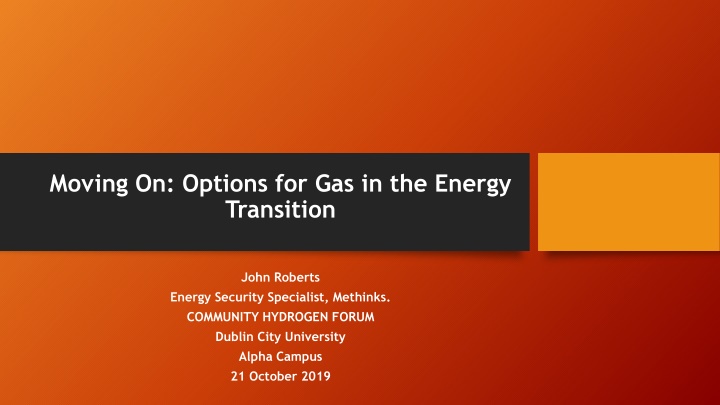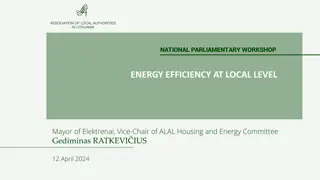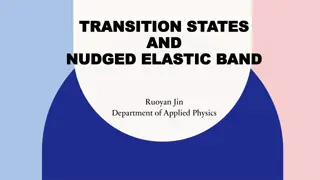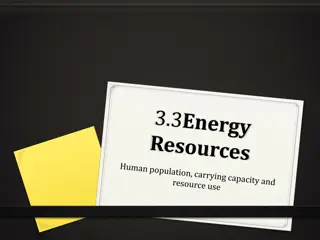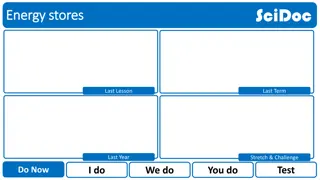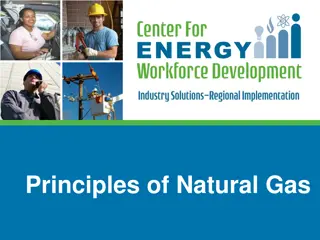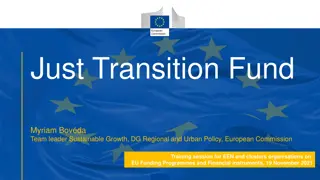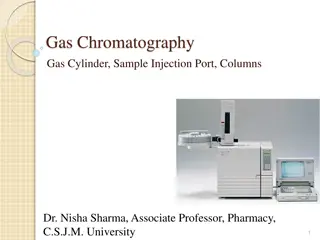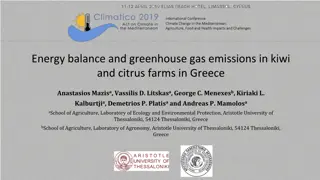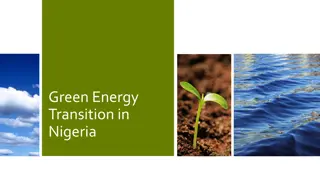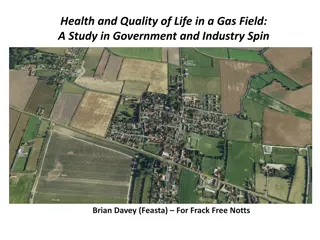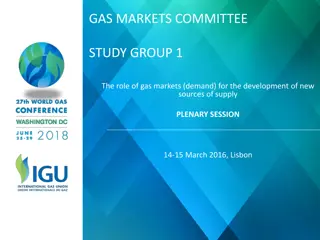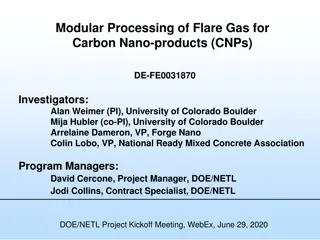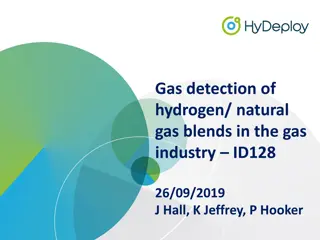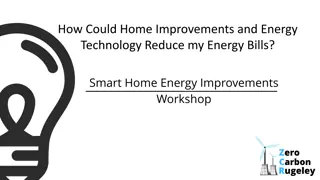Options for Gas in the Energy Transition
Energy transition towards renewable sources like hydrogen, the EU's stringent targets for renewables, global greenhouse gas emissions scenarios, energy intensity trends, and the impact of population growth on energy demand are discussed. Structural changes, efficiency improvements, and the need for diverse energy sources to meet the growing demand are highlighted.
Download Presentation

Please find below an Image/Link to download the presentation.
The content on the website is provided AS IS for your information and personal use only. It may not be sold, licensed, or shared on other websites without obtaining consent from the author.If you encounter any issues during the download, it is possible that the publisher has removed the file from their server.
You are allowed to download the files provided on this website for personal or commercial use, subject to the condition that they are used lawfully. All files are the property of their respective owners.
The content on the website is provided AS IS for your information and personal use only. It may not be sold, licensed, or shared on other websites without obtaining consent from the author.
E N D
Presentation Transcript
Moving On: Options for Gas in the Energy Transition John Roberts Energy Security Specialist, Methinks. COMMUNITY HYDROGEN FORUM Dublin City University Alpha Campus 21 October 2019
Energy & Tourism - Ireland 2 The West Offaly power station, in Shannonbridge, Co Offaly Photo: Irish Times 23 July 2019 Power Lines. Photo: Irish Times 18 August 2015
3 European Union: Renewables objectives The EU 2030 Framework for climate and energy promotes stringent targets and policy objectives for the period 2020-2030. In the EU, a 40% cut in greenhouse gas emissions compared to 1990 levels and at least a 27% share of renewable energy consumption, will make renewables the biggest source of primary energy in the EU in the long-term.
Global temperature increases Source: IIASA 4 Global GHG emissions in different Scenarios Reference: SSP2 assumptions Reference technology NDCs*: Regional GHG emissions caps based on national Paris pledges Continued ambition post-2030 Paris to 2C: Regional GHG emissions caps based on national Paris pledges Enhanced ambitions post-2030 to achieve 2 C goal Reference : 4.2 C temp increase NDC : 3.0 C temp increase P2C: 2.1 C temp increase
5 Energy Intensity UNECE Energy Intensity (GJ per 1,000 USD), comparison for three reference scenarios for all technologies Access to new technologies is the main driver for energy intensity. Is decline in energy intensity a result of a cyclical trend in improvements in energy efficiency and technological developments? Would we be on target just with reference scenario? Compare scenarios. Decline in energy intensity implies improvements in energy efficiency. Are we on track to meet energy efficiency targets as a region? Or are we lagging behind due to lack of effective implementation and realisation of the existing policies and regulatory frameworks? How does it vary on a subregional level across ECE region? (see next slide)
Energy & population growth Source: UNECE, Pathways for Sustainable Energy Project 6 According to World Bank, global opopulation will continue to grow, reaching 9 billion by 2040. Current energy production cannot support the anticipated increase in energy demand What energy sources are expected to meet growing demand? Hydrocarbons Nuclear Renewables Other. Structural changes will occur that will improve efficiency. Demand for primary energy will decrease. 400 10.0 Primary Energy Primary Energy Demand (mmboe/d) 350 9.0 Population 300 8.0 Population (billions) 250 7.0 200 6.0 150 5.0 100 4.0 50 3.0 1965 1975 1985 1995 2005 2015 2025 2035
UNECE: Energy expenditure as a share of GDP Source: IIASA 7 UNECE Energy Expenditure as a share of GDP % QUESTIONS: What changes can be expected in energy expenditures. How much does es it differ by sub-region and by scenario? Are end-users willing to pay extra to have access to cleaner energy sources?
UNECE: The Fuel Mix in electricity generation 2010-2050 (in TWh) Source: IIASA 8 P2C Scenario Reference Scenario Electricity generation mix [TWh], REF scenario, UNECE Other Wind Offshore Wind Onshore CSP PV Geothermal Biomass CCS Biomass Hydro Nuclear Gas CCS Gas Oil CCS Oil Coal CCS Coal Electricity generation mix [TWh], P2C scenario, UNECE 20 000 Other Wind Offshore Wind Onshore CSP PV Geothermal Biomass CCS Biomass Hydro Nuclear Gas CCS Gas Oil CCS Oil Coal CCS Coal 20 000 18 000 18 000 Electricity generation [TWh] 16 000 Electricity generation [TWh] 16 000 14 000 14 000 12 000 12 000 10 000 10 000 8 000 8 000 6 000 6 000 4 000 4 000 2 000 2 000 0 0 2010 2015 2020 2025 2030 2035 2040 2045 2050 2010 2015 2020 2025 2030 2035 2040 2045 2050
UNECE: Cost trends in electricity generation 2010-2050 Source: IIASA 9 P2C Scenario Reference Scenario Electricity generating cost trends: UNECE, P2C Scenario Electricity generating cost trends: UNECE, REF Scenario 160 70 60 140 US$/MWh at 2010 US$ US$/MWh at 2010 US$ 50 120 40 100 30 80 20 60 10 40 0 20 2020 2025 2030 2035 2040 2045 2050 Coal Gas PV Wind 0 2020 2025 2030 2035 2040 2045 2050 Coal Gas PV Wind
Energy Transition: Complex relationships 10 Decarbonisation, sustainability & affordability The cost of investment The cost of failing to take action
Gas: Transition fuel or destination fuel? 11 The IIASA Model: As a transition fuel whose use has to be curtailed to meet the Paris targets, the P2C scenario envisages natural gas being responsible for generating 1,751 TWh n the UNECE region in 2050. As a destination fuel, IIASA s Reference scenario estimates gas would quadruple its contribution to electricity generation in the UNECE region, reachiing 7,135 TWh in 2050.
Gas & Renewables: Compliment or Competition? 12 Commercial competition with renewables in some areas Social opposition in others Regulation and taxation: the importance of market design
Gas Use in the UNECE Region 2010-2050 Source: IIASA 13 P2C Scenario Reference Scenario Gas use in the UNECE Region under the P2C Scenario Gas use in the UNECE Region under the REF Scenario 120 120 100 100 Uses of natural gas [EJ] Use of natural gas [EJ] 80 80 60 60 40 40 20 20 0 0 2010 2015 2020 2025 2030 2035 2040 2045 2050 2010 2015 2020 2025 2030 2035 2040 2045 2050 Exports Electricity Electricity CCS District heat Synfuels Synfuels CCS T/D losses Feedstock Transportation Industry Resident/Commercial 2010 2015 2020 2025 2030 2035 2040 2045 2050 0 20 Uses of natural gas [EJ] 40 60 80 100 120 Gas use in the UNECE Region under the REF Scenario
UNECE: Gas Trade in WEU Sub-region 2010-2050 Source: IIASA 14 Natural gas trade / ref scenario 2030 Natural gas trade / NDC scenario 2030 Natural gas trade / P2C scenario 2030 250 250 250 200 AFR 200 AFR 200 AFR MEA MEA MEA Bcm per year Bcm per year Bcm per year 150 WEU 150 WEU 150 WEU SCS SCS SCS RUS 100 100 RUS RUS 100 NAM NAM NAM EEU 50 EEU EEU 50 50 CAS CAS CAS BMU 0 BMU BMU 0 0 BMU CAS EEU NAM Importing region RUS SCS WEU CPA SAS BMU CAS EEU NAM Importing region RUS SCS WEU CPA SAS BMU CAS EEU NAM Importing region RUS SCS WEU CPA SAS Natural gas trade / P2Cscenario 2050 Natural gas trade / ref scenario 2050 Natural gas trade / NDC scenario 2050 400 350 450 400 350 300 AFR 250 AFR 350 AFR 300 MEA MEA 300 MEA Bcm per year Bcm per year Bcm per year 250 WEU 200 WEU 250 WEU SCS 150 SCS 200 SCS 200 RUS RUS 150 RUS 150 NAM 100 NAM NAM 100 EEU 100 EEU 50 EEU CAS CAS CAS 50 50 BMU 0 BMU BMU 0 0 BMU CAS EEU NAM Importing region RUS SCS WEU CPA SAS BMU CAS EEU NAM Importing region RUS SCS WEU CPA SAS BMU CAS EEU NAM Importing region RUS SCS WEU CPA SAS
Western Europe: Dependence on Russian Gas 2015-2050 Source: IIASA 15 Natural gas trade / ref scenario 2050 Natural gas trade / ref scenario 2030 Natural gas trade / 2015 250 400 250 350 AFR 200 200 AFR 300 AFR MEA 250 MEA MEA Bcm per year Bcm per year Bcm per year WEU 150 150 WEU WEU SCS 200 SCS SCS RUS 150 RUS RUS 100 100 NAM 100 NAM NAM EEU EEU EEU 50 50 CAS 50 CAS CAS BMU 0 BMU BMU 0 0 BMU CAS EEU NAM Importing region RUS SCS WEU CPA SAS BMU CAS EEU NAM Importing region RUS SCS WEU CPA SAS BMU CAS EEU NAM Importing region RUS SCS WEU CPA SAS
Missing Elements 16 CCS and Hydrogen When will they enter service? How much will they cost? The competition from renewables.
Gas market diversification Source: IIASA 17 Natural gas trade / ref scenario 2050 Natural gas trade / ref scenario 2030 Natural gas trade / 2015 500 300 250 450 250 400 SAS 200 SAS SAS 350 CPA CPA CPA 200 WEU 300 WEU Bcm per year WEU 150 Bcm per year Bcm per year SCS SCS 250 SCS 150 RUS RUS 100 RUS 200 100 NAM NAM NAM 150 EEU EEU 50 EEU 100 50 CAS CAS CAS 50 BMU BMU 0 BMU 0 0 BMU CAS EEU NAM Exporting region RUS SCS WEU MEA AFR BMU CAS EEU NAM Exporting region RUS SCS WEU MEA AFR BMU CAS EEU NAM Exporting region RUS SCS WEU MEA AFR Exporters seek diversification (demand security) Russia s leading export role not only unchallenged but expanding export to ECE and east to CPA (China) and SAS (India)
UNECE: Electricity consumption: A preference for renewables Source: IIASA 18 Electricity Consumption per Capita (MWh per capita), reference technology, all scenarios Electricity Consumption per Capita (MWh per capita), reference scenario technologies comparison
Emergence of low carbon emitting technologies in electricity generation 19 Electricity Generation UNECE, Reference vs. NDC Scenario Wind Offshore 3 000 Wind Onshore 2 500 CSP 2 000 PV Geothermal 1 500 Biomass CCS 1 000 Biomass TWh 500 Hydro Nuclear 0 Gas CCS - 500 Gas -1 000 Oil CCS Oil -1 500 Coal CCS -2 000 Coal 2020 2025 2030 2035 2040 2045 2050
EU: The potential for hydrogen - 1 Source: Presentation by Florian Marko, Austrian Federal Ministry of Sustainability & Tourism, UNECE, Geneva, 24 September 2019. 20 bmnt.gv.at EU Long-Term Strategy Source: Long-Term Strategy 2050 of the EC, 2018; PRIMES 4
EU: The potential for hydrogen - 2 Source: Presentation by Florian Marko, Austrian Federal Ministry of Sustainability & Tourism, UNECE, Geneva, 24 September 2019. 21 bmnt.gv.at EU Long-Term Strategy Source: Long-Term Strategy 2050 of the EC, 2018; PRIMES 5
Questions? 22 John Roberts New Mill House22 Jedburgh TD8 6TH Scotland UK Email: john.roberts@methinks.org.uk Tel: +44-1835-863725 (home) +44-7966-290354 (mobile)
